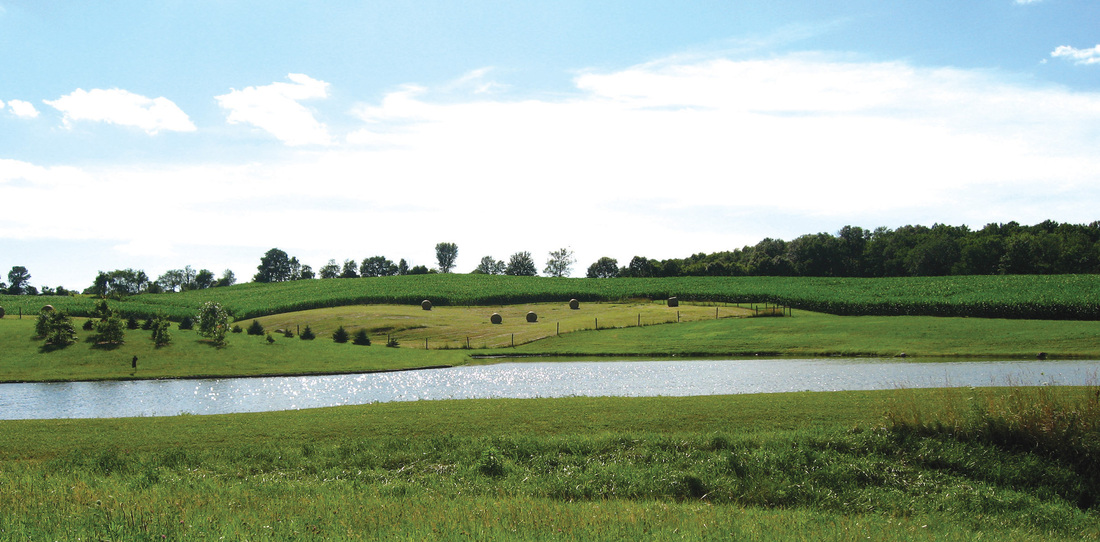About Knox County, Ohio
Educational Opportunities
Alumni Network
The Archive
Additional Resources
Introduction
Knox County (pop. 61,000) is located in the geographic center of Ohio, approximately fifty miles northeast of Columbus. Agricultural fields and woodlands cover much of the county’s gently rolling hills, broken by several streams that feed the Kokosing and Mohican Rivers. Mount Vernon (pop. 17,000) is the only city and the county seat. Additional municipalities include the villages of Centerburg, Danville, Fredericktown, Gambier, Martinsburg, and Gann (Brinkhaven). The county is divided into twenty-two townships, which serve as the basic political subdivisions outside of the incorporated city and villages.
Background
The area now known as Knox County was initially home to many Native Americans, including the Adena tribes, who were its first farmers. The rich lands and abundant water provided food and other resources to the Adena, as well as to fur trappers and early pioneers who traversed the area in the mid- to late- 1700s. Permanent settlement reached the area by 1800, facilitated by the 1795 Treaty of Greenville, which banished Native Americans northwest of a line that would become the county’s northern boundary. Knox County was formally incorporated in 1808 and named after Henry Knox, a general in the American Revolution and Secretary of War during George Washington’s administration.
By 1830 the period of pioneer settlement had largely ended, replaced by an era of growth that would continue for over a century. White Protestant immigrants from Britain and the mid Atlantic and Upper-Southern states comprised the vast majority of the population, but the community has always known some diversity. African Americans took up residence from earliest settlement; after 1900, industry attracted Black laborers, and the Black population numbered nearly 500 by 1950. Greek, Belgian, and Jewish communities, often numbering little more than several extended families, also settled the area. Amish have settled in the county in increasing numbers since the 1970s.
By 1830 the period of pioneer settlement had largely ended, replaced by an era of growth that would continue for over a century. White Protestant immigrants from Britain and the mid Atlantic and Upper-Southern states comprised the vast majority of the population, but the community has always known some diversity. African Americans took up residence from earliest settlement; after 1900, industry attracted Black laborers, and the Black population numbered nearly 500 by 1950. Greek, Belgian, and Jewish communities, often numbering little more than several extended families, also settled the area. Amish have settled in the county in increasing numbers since the 1970s.
The Economy
Knox County has long enjoyed a stable and diverse economy, mixing agriculture, manufacturing, and services. The C & E Cooper Company (now owned by Rolls Royce) established itself in Mount Vernon in the 1830s, soon becoming the industry leader in steam engines. By 1900, Mount Vernon was home to as many as eight glass companies, which continued production well into the century. Today, a number of construction, engineering, and light manufacturing operations have their headquarters in Knox County. The county is also home to Kenyon College and Mount Vernon Nazarene College, and its historical and cultural attractions make it a destination for tourism.
Agriculture
Agriculture has played a major role in the history of Knox County and is still its primary business. In the early 1900s, the county was known as the sheep capital of America, and it today remains the largest sheep- and wool-producing county in Ohio. But the varied terrain supports a wide range of agricultural activities. Dairy products represent 23% of annual agricultural output, followed by corn (23%), beef (13%), swine (12%), soybeans (9%), and poultry and other products (11%). Small-scale family farming still dominates agricultural production, although in the past fifteen years the number of operations has declined and the average farm size has increased.
Knox Today
With the recent expansion of Columbus, Knox County has begun to experience a new period of development and growth. Current projections predict that the population will reach 65,000 by 2020, an increase of 26% over the 1990 population. Increases in traffic and new housing starts are already evident in many areas. In response to these changes, the county has begun long-range planning and initiated efforts to direct the course of change and to preserve rural character.

